Revealing mistake: During the "Dawn of Man" sequence, the ape-man scenes were shot on an indoor stage with projected background images on a huge screen behind the stage. The screen itself was a highly reflective cloth. In most shots, it is quite convincing, but in several (especially when facing the aggressive, victorious group during the first fight, then again when facing the tool-using group in the last fight), the rear screen appears to be a patchwork of smaller pieces of cloth as very obvious puzzle-like shapes of varying reflectivity appear in the sky. Once you notice them, it's incredibly distracting. It was originally parallel strips, but they were VERY visible as vertical lines so they were torn into a patchwork to make lines less obvious. (00:08:35 - 00:18:00)
Continuity mistake: In a sequence in the cockpit of the space ship approaching docking, the shot shows the two pilots and 3 monitor screens between them. The right-hand screen changes from a data display to a blank showing only the letters "GDE" (possibly "GOE"). The next shot is a close-up of the three monitors, and the right-hand one now shows its earlier data display. The other two do not show this behaviour. (00:25:00)
Continuity mistake: During Heywood's meeting with Elena and Dr Smyslov, he is introduced to their colleagues, including Dr Kalinan who is the women in the olive dress/suit. When they shake hands her coat is folded neatly over her seat, but before she sits down again with the camera now facing Heywood, the coat disappears. In an earlier shot prior to the introduction, the majority of Kalinan's coat is off the seat and when she stood the first time it probably fell, suggesting the handshake sequence was re-filmed after the actual meeting. (00:28:45)
Continuity mistake: When Floyd and his team are heading to the Lunar excavation site, they start to eat those synthetic sandwiches. One of the shots shows a closeup of Floyd. As he is right about to take a bite, the camera cuts back to a shot of the three men. However, Floyd's sandwich is instantaneously about a foot from his mouth and he is fully chewing. (00:47:50)
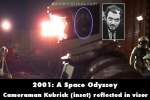
Visible crew/equipment: When the astronauts are approaching the monolith on the moon, you can see the reflection of the cameraman in the visor of the first astronaut off the ramp, in the close up of him walking around the monolith. This shot was personally filmed by Stanley Kubrick and the reflection is his own. (00:48:40)
Continuity mistake: Frank is running around the centrifuge. He passes the ladder with two bunks to the right and the work station to the left. When Dave comes down the ladder, the bunk is to the left. This error is caused by Frank's last two running shots (the ones where the camera stayed just ahead or just behind him as he ran) having been accidentally reversed in editting. Frank's hair is parted on the wrong side and the sleep tube layout and the body positions within are precise mirror images of the layout seen in all prior and following shots. (00:56:50 - 00:57:55)
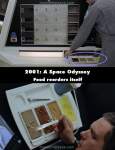
Continuity mistake: When Dave gets his supper, the order of the slop from right to left is yellow, light brown, light brown, dark brown. Later when he's eating, the order is yellow, orange brown, dark brown, light brown. (00:59:00 - 00:59:50)
Continuity mistake: Dave only takes one utensil on his tray, later he has two. (00:59:00)
Continuity mistake: When HAL asks Dave the personal question after inspecting his renderings, the position of the sketch pad changes between shots: right side of body to left side, on his lap, etc. (01:06:15)

Visible crew/equipment: When David walks with the case in the hand inside the Discovery One, you can see the dolly track below at David's feet blending in the structure. (01:12:12)
Continuity mistake: As Bowman enters B-pod to retrieve the AE-35 Unit, he lifts his left foot into the pod first. But as Poole is watching him do so on a monitor, Bowman lifts his right foot into the pod first. (01:12:45)

Continuity mistake: When Frank Poole and Dave Bowman are discussing with HAL the possibility of HAL being in error predicting the AE-35 Unit fault, the 10x3 grid of buttons on the console in front of them is lit differently depending on whether the shot is from behind the men, or in front of them. (01:20:40 - 01:23:00)
Continuity mistake: When Bowman attempts to rescue Poole, he enters "C-pod" which, from HAL's vantage point, is the right-most pod. But when we see a close-up of the pod's door closing, we see it is located on the center pod platform, meaning this is B-pod, not C-pod - yet B-pod is the one Poole was using and it is tumbling away in space at this time. We can also see, just barely, that all three pods are present in this same shot. (01:32:45)
Revealing mistake: When Dave Bowman is attempting to break into the Discovery after being locked out by Hal you can see, reflected in the Pod window as the Pod is spinning around, the edges and top corner of the small set of the Discovery hatch area. (Second timecode is accurate for DVD release) (01:43:00 - 01:46:50)
Other mistake: When Dave is deactivating HAL, he unlocks memory blocks one by one by turning a key for every one of them. When he's done the first five memory blocks, from number 6 to 2, he changes the key from right to left hand, and jumps to the logic terminal blocks, unlocking number 5 of those. However, number 1 of the memory blocks slides out. (01:48:20)
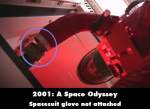
Continuity mistake: After David Bowman returns to Discovery One, HAL disables all life support systems in order to protect "himself" from being shut off. But Bowman successfully enters the ship, grab a helmet and goes to the Logic Center, to shut down HAL by disabling the Memory Banks. But, when opening the hatch to enter the Memory Bank, you can see his naked left wrist, for the spacesuit and the glove are disconnected. (01:51:10)
Continuity mistake: In several scenes, we are given HAL's visual perspective as if seeing through his lens. This is done with an overlayed image of the lens on whatever area is in sight of the lens. As Dave is entering HAL's memory circuit room (red lighting), one shot again suggests we are again seeing what HAL sees, but there is no HAL lens located and oriented to provide the angle we see. A lens would need to be mounted on the narrow wall directly opposite the circular doorway, yet HAL's lens in this room is mounted on the 'ceiling'. (01:51:25)
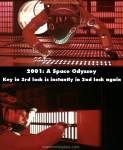
Continuity mistake: When Dave begins to disconnect HAL's circuits, one angle shows him unlock the first, second, then third unit. Just as he's about to remove the key from the third lock, the angle changes and he's pulling the key from the second lock and then goes for the third again. We know this is consecutive time as HAL is pleading with Dave the entire time. (01:51:45)
Other mistake: There is something drastically wrong with the design of the spherical 'Aries' moon shuttle. Some seats and many fixtures are 'upside down' relative to the up-down orientation of the shuttle itself, and we see loose food trays and equipment about the place as if this is routine. But - the shuttle is designed to land on the moon. What happens then? The moon has gravity, remember? There are going to be quite a few very disgruntled people dangling upside down like spiders, and there will be loose gear (and perhaps a stewardess or two) bouncing about all over the place. It is not a matter of stowing loose gear or lying flat on landing - some parts of the shuttle are upside down relative to others, which is why the stewardess has to do that famous 180 degree upside down walk. Whichever way you look at it the shuttle is going to encounter serious problems when it reaches a gravity well, which will occur whenever the engines are fired up, never mind landing on the moon.
Revealing mistake: When we see the space station from the cockpit of the approaching shuttle, the station does not appear to rotate because the shuttle is rotating at the same speed. OK...except that the station IS still rotating with respect to the sun, which means that the light source and shadows on the station should be moving.
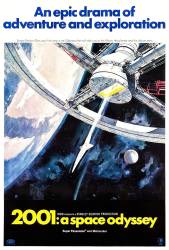





Suggested correction: The shuttle lands "on its back" with legs extending beyond the engines. As in most traditional sci-fi, and ALL actual, space flights to date, the launch (and landing) orientation for humans is to be on one's back. This minimizes blood being sucked down to your feet if you were sitting upright at launch - you could pass out. So we see this when the shuttle lands on the moon - the cockpit (red window) faces up (pilots on their backs, facing out the window). When we presume that the passenger cabin was 180 degrees spun around from the cockpit seating, they're still on their backs. Any loose objects would have been stowed before landing - the airlines don't lock down your bags, newspapers and coffee cups, right? They're loose in the cabin during flight, but put away on takeoff and landing.
Airliners do not fly upside down. The Orion shuttle cannot possibly operate the way it does if it lands in a gravity environment - some rooms are upside down relative to others - why else would the stewardess do the 180 degree vertical walk? It is an idiotic design flaw, and the posting is 100% correct.
The Aries passengers sit and stand with their feet down towards the moon. The pilots sit with their back down to the moon, as conventional astronauts do on Earth. But the attendant's 180-degree walk is completely wrong to the orientation of the shuttle's interior: it should have been only 90° if you look at the Aries exterior. One assumes that Kubrick preferred a longer, more cinematic shot, over a technically accurate shot. But nobody was upside-down to the moon.